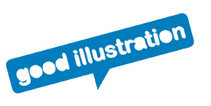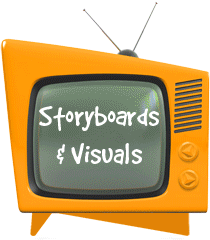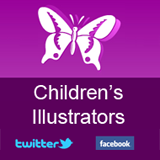How did you enter the world of children’s publishing and can you elaborate on your subsequent rise to the position of Art Director at HarperCollins?
My entry into children’s publishing was fairly serendipitous. I had just moved to New York City and was looking to take a full-time job (in any field) while pursuing a degree in Graphic Design at night. As it happened, on my first day in the city, I ran into an old college friend of mine, who happened to be working at Scholastic Inc. She told me about an editorial-assistant position that had come available and urged me to send in my resume. While I didn’t hear back about that job, I did unexpectedly receive a call from David Saylor (Creative Director), who was looking to hire a design assistant. He knew that I didn’t have any previous graphic design experience, and was kind enough to take a chance with me and act as a mentor. Thanks to him, I got a first-rate design education that far surpassed anything I would have received in a classroom setting. Needless to say, I never made it to design school.
After Scholastic, I went on to work at Simon & Schuster, Henry Holt Books for Young Readers, Scholastic Inc. (for a second time), and am now at HarperCollins. Having moved around quite a bit in the last 10 years, I’ve had the opportunity to work with many talented individuals and experience different publishing styles. The result is a broad, well-balanced industry perspective that I draw on constantly in my current role as Art Director.
Tell us a little about a recent project you have worked on, the stages involved and why you chose the selected illustrator(s).
I’m currently working on a hysterical new illustrated chapter book series called OTTO UNDERCOVER, by Rhea Perlman. This is an offbeat and quirky series about a 10-year-old boy who is a secret agent disguised as a professional racecar driver. His sidekick, Racecar, is basically a tricked-out James Bond car to the tenth power. Given his name, Otto Pillip is also wild for palindromes.
After reading the manuscript I realized I needed to find someone with a wild and vivid imagination who would be able to visually translate the wackiness of this story. I utlimately chose Dan Santat — whose work I was familiar with from working at Scholastic. Dan’s illustration style is highly imaginative, and I instantly knew he would be a good fit based on his humorous and over-the-top sensibility. Choosing the right illustrator is very much about drawing on your gut instincts.
Could you select two of your favourite children’s books, one from your own lists and another – and tell us what makes these titles special.
I have so many favorite chidren’s books that it’s extremely difficult to choose just two. But I can cite two of my current favorites, both of which also happen to be illustrated by their respective authors.
From HarperCollins’ list: KITTEN’S FULL MOON, by Kevin Henkes. It’s about a kitten who sees her first full moon and mistakes it for a big bowl of milk. The story follows her misadventures as she tries to steal a lick. The book is poignantly illustrated in black and white, and each spread is so beautifully thought out that the illustrations alone carry the story. It is also thoughtfully designed from cover to cover. This book goes right for the heart; no wonder it won the 2004 Caldecott Award.
From Hyperion’s list: DON’T LET THE PIGEON DRIVE THE BUS, by Mo Willems. The book starts off with the bus driver announcing that he has to leave for a short while, and instructs the reader to not let the pigeon drive the bus. The pigeon pleads and pleads, but is turned down at every page turn. Mo’s illustrations are so wonderfully minimalist, yet so full of expression. At one point the pigeon throws a temper tantrum and Mo brilliantly expresses the bird’s frustration (in a silent spread) with a simple frenzied squiggly line above the pigeon’s head. I couldn’t imagine this spread being done any other way.
How often do you work with illustrators from outside the US?
About 80% of the illustrators I use are based in the U.S., although I’ve recently started to use more artists based in the UK. Editorial artists in the UK are doing wonderfully innovative work that looks totally unlike much of what’s being done in the U.S. today. There are several illustrators that are doing fantastic, dynamic compositions mixing contrasting mediums like photography and illustraion. When looking for something more unusual, I tend to head to UK-based agencies first.
Can you identify some of the current trends in children’s publishing and predict trends for 2006.
Talking about trends in publishing is tricky because the lead time is so great that it’s kind of like talking about the weather two years in advance. Middlegrade fantasy still continues to be strong, riding on the tail of Harry Potter, and teen “Chick-Lit” seems to be experiencing a decline due to market over saturation. I do, however, look forward to a growing number of graphic novels being published in the near future. While not a new genre, it has been overlooked by mainstream publishers, and is finally enjoying a revitalization.
How much influence do the Sales / Marketing depts have over your work?
Sales and Marketing are playing an increasingly larger role in determining the look of a book. Each cover I oversee goes through a series of checks and balances that includes input from the sales and marketing teams.
Publishers in the U.S. have learned that it’s vitally important to appeal to the needs of our biggest booksellers, as they are often the greatest source of revenue. If a bookseller says a particular cover design will make the difference between a book selling ten- and fifty-thousand copies, the publisher will obviously try to accommodate their suggestions.
Is it important for you to keep the author involved during the artwork progression / selection process, or is this the publisher’s responsibility?
It really depends on the book. Unless the author is also the book’s illustrator, it’s generally easier if they are not involved in the design process. That said, it’s ultimately up to the editor to serve as liaison and determine the level of author involvement (which is sometimes written directly into the contract). In certain instances, however, I will speak with the author directly, to better convey an idea or make the case for a specific type of cover treatment.
Could you explain how Harper Collins is structured in terms of royalties?
Royalty structures vary between picture books and novels, with picture book authors and illustrators generally each receiving royalties, while novel authors alone receive royalties. In rare instances, novel illustrators are able to negotiate a small royalty in addition to a flat fee, but they typically have a certain stature within the industry.
Do you attend any trade events? If so, which ones do you consider important and why.
I unfortunately don’t attend as many trade events as I would like. Most recently, I attended Book Expo America, which was mind blowing; the number of independent publishers was absolutely staggering. It was inspiring to see so many people so personally vested in book publishing.
What advice would you offer to illustrators looking to impress you with the presentation of their work?
Self-promotion is a very important part of being a freelance illustrator, and I encourage people to be as creative as they can. I get over a hundred postcard mailers a month and, after a while, they all start to look alike. The most original and creative mailers are the ones that make me take a closer look. My favorite self-promotion piece to date came in the form of a self-made envelope that was fully illustrated both inside and out. It was so clever that I wanted to learn more about the person’s work. In the process, I discovered a page on the illustrator’s website where you could download the envelope template and print it out on your own ink-jet printer – to use yourself. It was a great example of an eye-catching mailer that was inexpensive to reproduce and even adapt for personal use.
I would also encourage every illustrator to have an attractive and user-friendly website. As I don’t have time to schedule in-person portfolio reviews, and I rely heavily on being able to quickly browse through someone’s work online. In the same vein, I would also recommend providing easily printable work samples. Often people make the mistake of making their online portfolios so flashy or gimmicky that it becomes clumsy, difficult, and time consuming to maneuver through. Less is more in this case.
Harper Collins works regularly with many talented illustrators. Would you commission a fledgling illustrator, or do you prefer only to work with established illustrators?
I am always looking for new talent, and would most definitely hire someone new to children’s books or the industry at large. I do, however, prefer to use seasoned illustrators for more complicated projects like heavily illustrated chapter books. These kinds of books are extremely time consuming to lay out, and it’s much more efficient to work with someone familiar with the format.
This interview has been syndicated courtesy of Childrensillustrators.com







